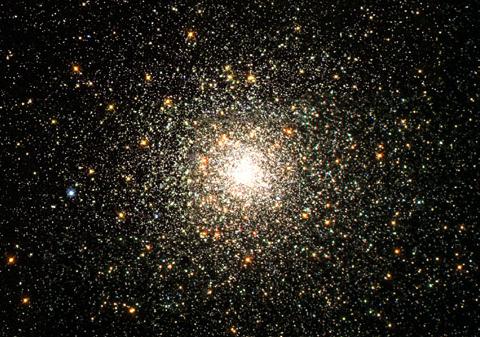Astrophysics
Subtopics: Two-Body Problem Three-Body Problem Million-Body Problem Trillion-Body Problem
 |
The globular cluster M80 as seen by Hubble Space Telescope (NASA). |
My main field of research in astrophysics is stellar dynamics, especially stellar dynamics of dense stellar systems, such as star clusters and galactic nuclei. In these systems, interactions between individual stars are significant for the evolution of the system as a whole. Gravitational deflections exerted by one star upon another can transport energy and angular momentum through the system, thereby changing the distribution of the stellar population, while collisions between two stars can directly alter the stars themselves.
The most interesting application of stellar dynamics of dense stellar systems is a detailed modeling of active galactic nuclei, which provide the fire works that power quasars. However, these systems are quite complex, and a more limited initial goal is to provide detailed models of the evolution of simpler star clusters. For example, in our backyard, intergalactically speaking, there are more than a hundred globular clusters nearby, in orbits around the Milky Way, our own Galaxy. They are old and contain hardly any gas, which makes them ideal laboratories for stellar dynamics.
One reason to study globular clusters is the notion that it would seem unwise to attempt to understand something so complex as a galactic nucleus as long as you cannot understand the evolution of a globular cluster. In that sense attempts to model the evolution of globular clusters can be seen as forming a stepping stone towards the study of more complex systems. Another reason to study globulars is related to the wealth of exotic objects they are now known to contain, such as blue stragglers, X-ray binaries, and millisecond pulsars. The formation and evolution of many of those systems is intimately tied to the evolution of the star cluster as a whole. In fact, a globular cluster can be seen as an ecological network, where the overall distribution of stars dictates binary (trans)formation, while the binary stars in turn power the post-collapse expansion of the outer regions of the cluster.
Similar techniques as are used for the study of globular clusters and galactic nuclei can be applied to other dense systems of particles. One example is the formation of planets from planetesimals in a proto-planetary disk. Another example is the evolution of galaxies in a rich cluster of galaxies. Whether the particles are stars, planetesimals, or galaxies, the dynamics of these systems is called `collisional' if either the two-body relaxation time or the physical collision time in the system is shorter than the age of the system. In both cases, memory of the initial conditions will have been largely erased through encounters, and the evolution can be understood through a detailed study of the thermodynamic transport of energy, angular momentum and matter.
Gravitational thermodynamics, while formally ill defined, in practice works fine as a tool to understand the evolution of dense stellar systems. Notwithstanding such unusual features as a negative heat capacity and a lack of a thermodynamic limit, many simulations and semi-analytic treatments of stellar systems close to equilibrium have been successfully carried out. Self-gravitating systems can never reach a complete equilibrium though: they eventually fall apart, by evaporating into a mist of escaping single stars, binaries, and occasional triples, leaving behind either nothing or a central black hole or perhaps a pair of black holes orbiting each other. For most astrophysical systems, the fact that they are still around is a reflection of the fact that their evaporation time is much larger than the current age of the Universe.